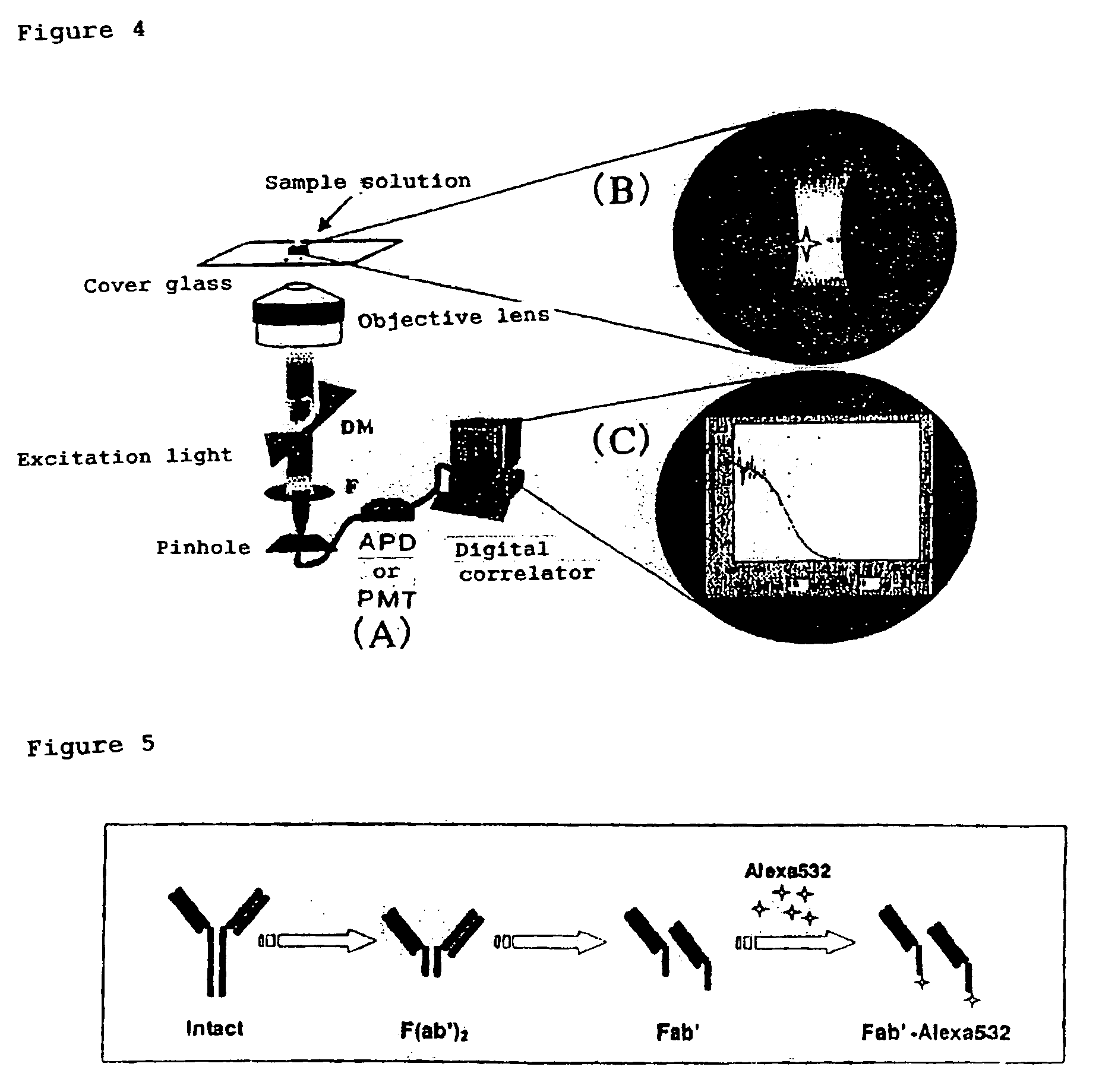Method of quickly detecting and/or assaying antigen by fluorescence correlation spectrometry
a fluorescence correlation and antigen technology, applied in the direction of fluorescence/phosphorescence, material analysis through optical means, instruments, etc., can solve the problems of animal death, brain spongiform, abnormal prions at those particular sites, etc., and achieve the effect of quick and convenien
- Summary
- Abstract
- Description
- Claims
- Application Information
AI Technical Summary
Benefits of technology
Problems solved by technology
Method used
Image
Examples
example 1
Influence of a Non-fluorescence-labeled Intact Antibody on Diffusion Rate
(1) Materials:
[0073]Alexa Fluor 647 (Zenon One Mouse IgG1 Labeling Kit)[0074]Fab 647 (Zenon One IgG1 Labeling Reagent)[0075]Antibody (indicated by Ab in FIG. 2) (Zenon One Blocking Reagent (mouse IgG))
(2) Apparatus for FCS Assay:[0076]MF-20 (intermolecular interaction analysis system: Olympus Corp.)
(3) Procedures:
[0077]A solution of 10 nM Fab 647 (mouse IgG antibody) alone and a Fab 647 mixture obtained by mixing Fab 647 with 100 nM intact antibody were applied to a 384-well plate (Olympus) blocked with N101 (NOF Corp.), followed by assay with MF20 (Olympus). The assay was performed by 30 sec.×three measurements at a laser power set to 100 μW. The processing software in MF20 was used to derive each parameter including diffusion time.
[0078]To test how a non-fluorescence-labeled intact antibody can influence the diffusion rate in the Brownian motion of an antigen / antibody complex molecule, an intact antibody and ...
example 2
Detection and Assay of Antigen (Antigenic Protein) using FCS
(1) Apparatus
[0080]FCS apparatus[0081]Intermolecular interaction analysis system (MF-20, manufactured by Olympus Corp.)
(2) Materials[0082]Preparation of fluorescence-labeled antibody fragment
[0083]In this Example, the fluorescence-labeled antibody fragment (Fab′-Alexa 532) of an anti-prion antibody was taken as an example. The outline of preparation of Fab′-Alexa 532 is shown in FIG. 5. An anti-PrP antibody solution was equilibrated with a citric acid solution (pH 6.3) by use of a PD-10 column (Pharmacia) and then supplemented (37° C., approximately 30 minutes) with pepsin (1% (w / w)) to prepare F(ab′)2. The degree of the digestion was confirmed by HPLC (column: G300SWXL). Then, the fragment was purified by FPLC (column: Superdex 200 (16 / 60)) using 0.1 M phosphate buffer solution (pH6.3), then concentrated, and stored. It was further reduced (37° C., approximately 1.5 hours) by the addition of 2-mercaptomethylamine (0.01 M) ...
PUM
| Property | Measurement | Unit |
|---|---|---|
| molecular weight | aaaaa | aaaaa |
| molecular weight | aaaaa | aaaaa |
| volume | aaaaa | aaaaa |
Abstract
Description
Claims
Application Information
 Login to View More
Login to View More - R&D
- Intellectual Property
- Life Sciences
- Materials
- Tech Scout
- Unparalleled Data Quality
- Higher Quality Content
- 60% Fewer Hallucinations
Browse by: Latest US Patents, China's latest patents, Technical Efficacy Thesaurus, Application Domain, Technology Topic, Popular Technical Reports.
© 2025 PatSnap. All rights reserved.Legal|Privacy policy|Modern Slavery Act Transparency Statement|Sitemap|About US| Contact US: help@patsnap.com



